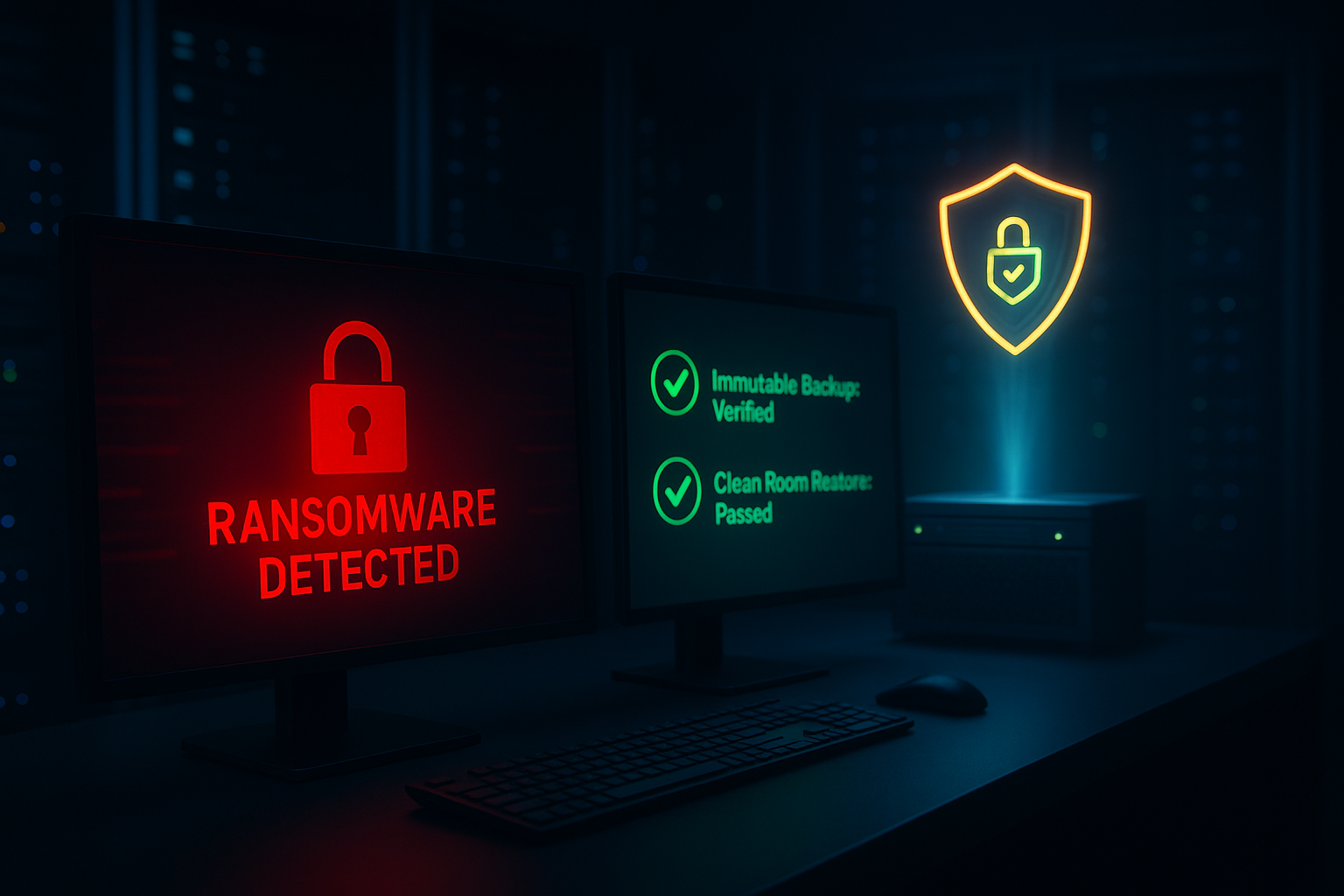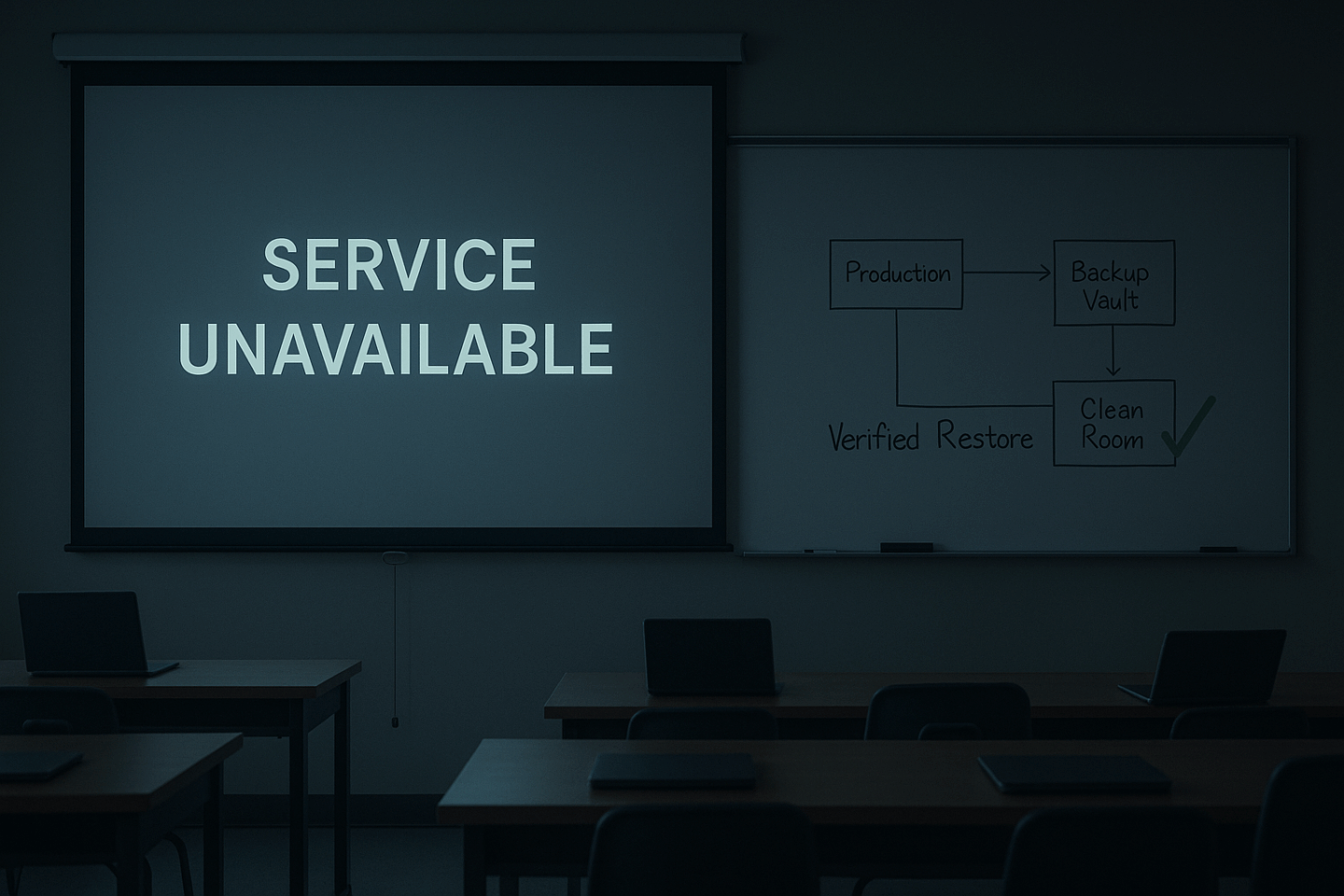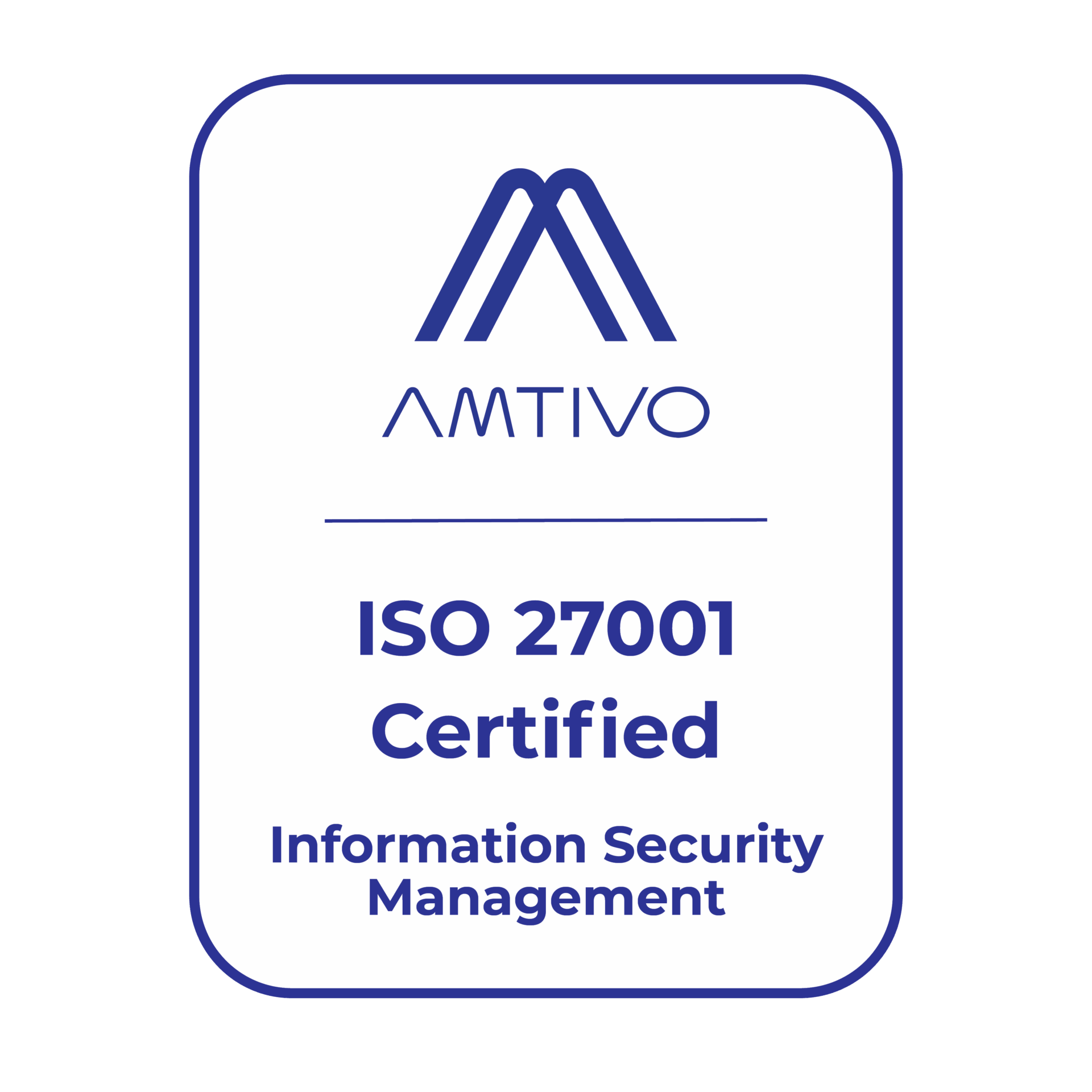DATA PROTECTION TRENDS, NEWS & BACKUP TIPS
Backup as a Service (BaaS) vs. Disaster Recovery as a Service (DRaaS): Understanding the Difference

Imagine coming into work to find a server failure or cyberattack has knocked your systems offline. Would your business be able to recover quickly, or at all? Questions like this weigh on many IT professionals in small and mid-sized organizations. The good news is there are services to ease these worries, namely Backup as a Service (BaaS) and Disaster Recovery as a Service (DRaaS).
These solutions both aim to protect your data and keep your operations running, but they serve different purposes. In this article, we’ll clarify what BaaS and DRaaS mean in plain language, explore when you might need one or the other (or both), look at real-world use cases, and explain how a trusted provider like CyberFortress (powered by Veeam Cloud Connect) can help. Our goal is to help you make a confident, informed decision about your data protection strategy.
What is Backup as a Service (BaaS)?
Backup as a Service is essentially an offsite, managed backup solution. In a BaaS model, you outsource the task of backing up your data to a specialized provider. Instead of handling backups on your own tape drives or local servers, your data is securely transmitted to the provider’s cloud infrastructure on a regular schedule.
The provider then stores those backup copies so you can restore files or entire systems from them if needed. In other words, BaaS means a third-party service keeps your business’s data safely backed up and readily available for recovery, without you having to manage the back-end mechanics.
According to one definition, BaaS is “a backup solution offered by managed service providers (MSPs) for businesses looking to back up and protect their data for restoration at the file or system level”. The key point: BaaS gives you reliable cloud backups, managed by experts, so you can get your data back in case of accidental deletion, hardware failure, or other everyday data loss incidents.
How BaaS works: Typically, the provider will deploy backup software (for example, Veeam) on your environment or appliances, which will encrypt and send your data to the cloud storage provided. Your data may be stored in a compressed, deduplicated format to save space. This means the backups efficiently use storage and can keep multiple versions of your data (daily snapshots, for instance). However, because the data is stored in an optimized state, restoring large amounts of data from backups can take some time. The backup files need to be “rehydrated” (decompressed and reconstructed) during recovery.
BaaS is ideal for long-term data retention and granular recovery. You can usually retrieve a file from last week or even last year because backups are retained for as long as you need. If a user accidentally deletes an important document or a server crashes, you can go to your cloud backups and restore the affected data at the file, database, or even whole-server level. What BaaS doesn’t necessarily do, however, is instantly run your business applications in the cloud, that’s where DRaaS comes in.
What is Disaster Recovery as a Service (DRaaS)?
Disaster Recovery as a Service takes business continuity to the next level by ensuring you can quickly recover entire systems or applications in the event of a major outage or disaster. In a DRaaS model, a provider continuously replicates your critical servers and applications to a cloud environment. If your primary IT infrastructure goes down (due to a natural disaster, major hardware failure, ransomware attack, etc.), the DRaaS provider can spin up the latest copy of your systems in the cloud, allowing your business to keep running on this secondary infrastructure.
One concise definition is that DRaaS “is a cloud-based solution that enables businesses to replicate critical workloads to a service provider’s infrastructure. In the event of downtime, these workloads can be quickly restored, ensuring minimal disruption to operations”. In plain terms, DRaaS is like having a hot standby environment that can take over for your production data center at a moment’s notice.
How DRaaS works: The DRaaS provider will typically use replication technology to keep an updated copy of your VMs (Virtual Machines), servers, or data in sync with the cloud environment. Unlike backups, which might run once a day, replication can be near-real-time or frequent, capturing changes as they happen (some solutions use continuous data protection). The replicated data in DRaaS is kept in a readily usable state, often as fully functional virtual machine copies. This means if disaster strikes, the provider can initiate a failover: your workloads switch to run in the provider’s cloud with very little delay.
Because this replicated data is not compressed/deduplicated to the same extent as in backups, it’s immediately available to be “powered on.” You trade off some storage efficiency for speed: more storage is needed to hold live replicas, and usually only the most current version of your data is maintained, but in return you get the ability to restore operations within minutes or hours instead of days. DRaaS often includes not just the cloud servers, but also the networking, IP reconfiguration, and all the orchestration needed to bring a whole environment online.
A good DRaaS will have runbooks or automated workflows so that, for example, your database servers come up before your application servers, your domain controllers authenticate everything, and so on, all coordinated by the provider to meet your recovery time objective (RTO). The result is a dramatically reduced downtime: even if your building’s power is out or your hardware is in ruins, your employees and customers can continue accessing critical applications via the cloud recovery site.
Key Differences Between BaaS and DRaaS
BaaS and DRaaS are related services (and often complementary), but they are not the same thing. Here’s a clear breakdown of how they differ:
- Purpose and Scope: BaaS is about data backup and recovery, whereas DRaaS is about full business continuity. BaaS protects your data, it ensures you have copies of files, databases, and system images that you can restore if needed. DRaaS protects your operational capability, it enables your whole IT environment (or key parts of it) to fail over to a cloud data center during a disaster so you can keep working. In short, BaaS = saving your data offsite; DRaaS = rapidly switching to a secondary infrastructure when your primary is down.
- Recovery Speed and RTO: BaaS typically has longer recovery times for large-scale failures, because restoring from backups means transferring data back and rebuilding systems. It might take hours to download and restore a multi-terabyte backup before you can use it. DRaaS is designed for speed, aiming to meet much lower RTOs (Recovery Time Objectives, often minutes or a few hours). Since DRaaS keeps systems pre-staged and data already in running format, you can bring up new instances almost immediately in the cloud. For example, if an on-premises server dies, with BaaS you’d reinstall the server and then recover the data; with DRaaS, you’d activate the cloud replica of that server and be up and running quickly.
- Data Versions and Retention: BaaS excels at retaining multiple versions of data over a long period. You might keep daily/weekly backups for months or years. This means if you need a file from last month, BaaS has you covered. DRaaS focuses on the most current copy of your systems needed for immediate recovery. It’s about near-term data – typically if you fail over, you get the latest state of your systems (as of the last replication). You usually don’t use DRaaS to recover a file from 6 months ago; you’d use BaaS for that. BaaS is like an archive of restore points, whereas DRaaS is a live mirror of your environment.
- Orchestration and Complexity: Recovering from BaaS is often a manual, one-system-at-a-time process, because backups are used for many routine restores (like an accidentally deleted email or a single VM). These scenarios don’t require complex coordination, you just restore the item and carry on. DRaaS involves orchestrated recovery of many systems together. In a full disaster, you might need to recover dozens of servers and services that interconnect (web servers, application servers, databases, authentication servers, etc.), and they need to come up in the right order. DRaaS providers therefore offer playbooks, automation, and testing to ensure that when you trigger a failover, all the pieces come up smoothly in the cloud. This orchestration is a key differentiator, backup alone doesn’t include that level of coordination.
- Cost and Resources: In general, BaaS is the more affordable service of the two, because you’re mainly paying for storage and a managed backup service. There’s no live infrastructure running on standby, you only incur costs when storing or retrieving backups. DRaaS is typically a higher investment because you are essentially maintaining a duplicate (virtual) data center environment ready to go. You pay for the storage of replicas and often for reserved compute resources or a subscription that guarantees cloud capacity for failover. However, DRaaS can save huge amounts in downtime costs when a disaster strikes, which for some businesses makes it well worth it. Think of it as an insurance policy: BaaS is like insuring your data, and DRaaS is insuring your entire business operations. In many cases, businesses will mix and match to control costs – only the most critical systems are covered by DRaaS (for fast recovery), while everything else is just backed up via BaaS with a longer restoration time acceptable. This tiered approach ensures you’re not overspending on near-instant recovery for systems that could be down for a day without major harm.
In summary, BaaS is storage-efficient and great for granular or historical data recovery, but it’s not designed to instantly revive your whole business. DRaaS is built for rapid recovery and keeping your business running, but typically only with the latest data state and at a higher cost/complexity. Both are vital tools in data protection, each addressing different risk scenarios.
When Do You Need BaaS vs. DRaaS (or Both)?
Given the differences above, you might be wondering which service your business actually needs. The answer depends on your specific risks, uptime requirements, and resources. Here are some guidelines and scenarios:
- Use BaaS if your main concern is data loss (not immediate uptime): If your priority is to ensure no data is ever permanently lost, and you can tolerate some downtime in a worst-case scenario, then a managed backup service might be enough. For example, a small business with a local file server might choose BaaS so that even if the server fails, they can restore yesterday’s data onto a new machine within a day. Many organizations choose BaaS because it has the lowest barrier to entry, you just install an agent and start sending backups offsite, and you’re protected against everyday incidents like accidental deletions or small outages. BaaS is a good starting point for companies that don’t have a formal disaster recovery plan yet; at least your data will be safe in the cloud, and you deal with rebuilding systems when needed.
- Use DRaaS if downtime is unacceptable for critical systems: If your business cannot function if certain applications are offline for more than a short time (be it minutes or hours), then you need more than just backups, you need DRaaS for those critical applications. Consider a mid-market ecommerce company that loses revenue every hour their website is down, or a healthcare provider that must keep patient data systems online 24/7. These are cases where having a ready-to-run replica environment is crucial. As one expert put it, most organizations have at least one workload they “can’t live without – even when all hell breaks loose”. DRaaS is designed for those high-priority workloads, ensuring they will be up in the promised timeframe no matter what disaster hits. If you have tight RTOs/RPOs in your business continuity plan, DRaaS is the tool to meet them. Keep in mind that implementing DRaaS requires planning and investment; you will work with the provider to define which systems are replicated, how to fail over your network, etc., but the payoff is peace of mind that even a major incident won’t cripple your business.
- Use Both for Comprehensive Protection: In practice, many businesses will find they need a combination of both services. BaaS and DRaaS are complementary, not mutually exclusive. You might put your mission-critical servers under a DRaaS plan to guarantee quick failover, while also backing up all your data (including less critical systems) to the cloud via BaaS. This way you have both immediate recovery for continuity and long-term backups for retention and compliance. For instance, an accounting firm might use DRaaS to keep its client database and email server running during a disaster, but also use BaaS to archive years’ worth of financial records to meet regulatory requirements. In fact, modern solutions like Veeam allow providers to offer integrated backup and replication in one package. You don’t necessarily have to choose one or the other. As Veeam’s experts often note, a robust strategy uses the two in tandem: BaaS for data insurance, and DRaaS for business continuity insurance. Many mid-market companies start with BaaS and later add DRaaS for critical workloads as they grow or when they realize the cost of downtime. The important thing is to assess your tolerance for downtime versus data loss: if you want near-zero downtime and no data loss, you’ll likely need both services in some measure.
Choosing a Trusted Provider (and Why CyberFortress)
Deciding on BaaS and DRaaS is only part of the equation, choosing the right provider is what turns those concepts into a practical, successful implementation. You’ll want a provider you can trust with your sensitive data and one with the expertise to actually recover your systems when something goes wrong. This is where CyberFortress comes in as a strong partner for SMB and mid-market IT teams.
CyberFortress is a global data protection provider that specializes in managed cloud backup and disaster recovery, and it is powered by industry-leading Veeam technology. In fact, CyberFortress is a Veeam Cloud Connect service provider, meaning it uses Veeam’s secure multi-tenant cloud platform to host off-site backups and DR environments for clients. With Veeam Cloud Connect, your backups and replica VMs reside in a hardened, secure cloud repository, and can be efficiently transferred and spun up on demand. For you, the customer, this means seamless integration if you’re already using Veeam backup software, sending backups offsite or failing over to the cloud is built into the service.
Perhaps more importantly, CyberFortress brings the human expertise that truly sets it apart. Many organizations don’t have in-house disaster recovery specialists (and hiring a full DR team is costly). CyberFortress fills that gap by providing a team of credentialed experts who live and breathe backup and recovery. As one report noted, DRaaS providers have experts that many organizations can’t afford to keep on staff full-time and “that is where CyberFortress comes in as your partner whose internal experts specialize in backup and disaster recovery, managing it all for you”. When you use CyberFortress BaaS or DRaaS, you’re enlisting seasoned professionals to set up your backups, monitor them, help define your disaster recovery plan, and even assist in testing and actual recovery events. This mindset means you don’t have to shoulder the burden alone, CyberFortress’s team is on call 24/7 if a crisis hits, ready to help you recover swiftly.
CyberFortress is also a proven, trusted expert in Veeam-powered solutions. They’ve been a Veeam partner for years and have developed solid services around it. (They are even recognized as an original Platinum Veeam Cloud Service Provider and have Veeam Certified Engineers on staff.) For you, this translates into confidence that the technology underpinning your BaaS/DRaaS is rock-solid and that the people managing it know exactly how to leverage it. CyberFortress offers both services as fully managed solutions – “Backup-as-a-Service (BaaS) and Disaster-Recovery-as-a-Service (DRaaS), both supported by credentialed Veeam experts who take the complexity out of data protection and disaster recovery”. In practical terms, CyberFortress can help you implement a plan where your data is automatically backed up offsite and your critical servers are primed for one-click failover through Veeam Cloud Connect. You get the best of both worlds in one package, with one vendor accountable for the outcome.
Another benefit of working with a provider like CyberFortress is the emphasis on testing and preparedness. It’s not enough to have backups and a DR plan on paper, you need to know they’ll work when needed. CyberFortress, aligning with Veeam’s best practices, encourages regular recovery testing and provides reports on your backup and DR health. This proactive approach, combined with the “sage” guidance of their experts, means you’ll get advice tailored to your business: for example, helping you set the right RPO/RTO targets, showing you how to tier your applications for recovery, and ensuring compliance needs are met. The outcome is a tailored BaaS/DRaaS strategy that fits your budget and risk tolerance, without wasted spend on unnecessary services or, conversely, without dangerous gaps in protection.
Making an Informed Choice
Building a resilient data protection strategy is about understanding your business needs and finding partners who can address them. Backup as a Service and Disaster Recovery as a Service each play a vital role: one protects your data, the other protects your business operations. For many SMB and mid-market companies, the right answer isn’t one or the other, but a thoughtful combination of both. By leveraging solutions like BaaS and DRaaS (especially when they’re integrated via platforms like Veeam Cloud Connect), you can sleep better at night knowing your data is safe and your business can bounce back from the unexpected.
If you’re unsure what mix of backup and disaster recovery you need, or you want to explore how these services could work for your specific environment, CyberFortress is here to help. Reach out to schedule a consultation with a CyberFortress expert today. We’ll happily assess your current setup, answer your questions, and help you design a BaaS/DRaaS solution that gives you confidence that no matter what happens. Your data deserves the best care, and with the right strategy in place, you can ensure that a setback never becomes a business-ending catastrophe. Let’s build your resilience together.






